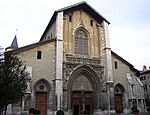Grand Chambéry
Agglomeration communities in FranceIntercommunalities of SavoieSavoie geography stubs
Grand Chambéry is the communauté d'agglomération, an intercommunal structure, centred on the city of Chambéry. It is located in the Savoie department, in the Auvergne-Rhône-Alpes region, southeastern France. It was created in January 2017. Its seat is in Chambéry. Its area is 526.5 km2. Its population was 134,377 in 2017, of which 58,919 in Chambéry proper.
Excerpt from the Wikipedia article Grand Chambéry (License: CC BY-SA 3.0, Authors).Grand Chambéry
Chemin de la Boisse, Chambéry Chambéry-le-Haut
Geographical coordinates (GPS) Address Nearby Places Show on map
Geographical coordinates (GPS)
| Latitude | Longitude |
|---|---|
| N 45.583333333333 ° | E 5.9166666666667 ° |
Address
Chemin de la Boisse
Chemin de la Boisse
73000 Chambéry, Chambéry-le-Haut
Auvergne-Rhône-Alpes, France
Open on Google Maps






